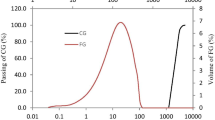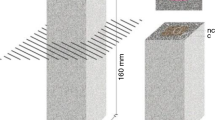Abstract
The use of alternative cements with lower CO2 emissions during production compared to ordinary Portland cement (PC) is only sustainable, if the durability and with it the service life of components and structures produced with them are not compromised. In this project, the carbonation resistance of mortars produced with calcium sulfoaluminate cement (CSA) and three different slag-based cements is studied in accelerated conditions and natural exposure. Additionally, the diffusion coefficients of oxygen (\(D_{{{\text{O}}_{2} }}\)) and carbon dioxide (\(D_{{{\text{CO}}_{2} }}\)) are measured (the latter one only on carbonated mortars) and the change in mortar porosity due to carbonation is determined. Mortar PC used as reference and mortar CSA display the lowest carbonation coefficients, both in accelerated conditions and natural exposure. The three systems based on slag display higher carbonation coefficients. After carbonation, the diffusion coefficient \(D_{{{\text{O}}_{2} }}\) is increased for all mortars except for mortar PC, whose total porosity is decreased as well, in contrast to all other mortars. The diffusion coefficients \(D_{{{\text{O}}_{2} }}\) and \(D_{{{\text{CO}}_{2} }}\) show a linear relationship in the carbonated mortars.









Similar content being viewed by others
References
Tuutti K (1982) Corrosion of steel in concrete. Svenska Forskningsinstitutet för cement och betong, Stockholm
Gonzalez JA, Andrade C (1982) Effect of carbonation, chlorides and relative ambient humidity on the corrosion of galvanized rebars embedded in concrete. Br Corros J 17:21–28
Papadakis VG, Vayenas CG, Fardis MN (1991) Physical and chemical characteristics affecting the durability of concrete. Mater J 88:186–196
Leemann A, Nygaard P, Kaufmann J, Loser R (2015) Relation between carbonation resistance, mix design and exposure of mortar and concrete. Cem Concr Compos 62:33–43
Leemann A, Moro F (2017) Carbonation of concrete: the role of CO2 concentration, relative humidity and CO2 buffer capacity. Mater Struct 50:30
Quillin K (2001) Performance of belite–sulfoaluminate cements. Cem Concr Res 31:1341–1349
Bakharev T, Sanjayan JG, Cheng YB (2001) Resistance of alkali-activated slag concrete to carbonation. Cem Concr Res 31:1277–1283
Puertas F, Palacios M, Vázquez T (2006) Carbonation process of alkali-activated slag mortars. J Mater Sci 41:3071–3082
Matschei T, Bellmann F, Stark J (2005) Hydration behaviour of sulphate-activated slag cements. Adv Cem Res 17:167–178
Hargis CW, Lothenbach B, Müller CJ, Winnefeld F (2017) Carbonation of calcium sulfoaluminate mortars. Cem Concr Compos 80:123–134
Bernal SA, Provis JL, Brice DG, Kilcullen A, Duxson P, van Deventer JS (2012) Accelerated carbonation testing of alkali-activated binders significantly underestimates service life: the role of pore solution chemistry. Cem Concr Res 42:1317–1326
Gartner E, Quillin K (2007) Low-CO2 cements based on calcium sulfoaluminates. Sustain Cem Concr Ind Nor Cem Assoc 16:95–105
Zhang L, Glasser FP (2005) Investigation of the microstructure and carbonation of CSA-based concretes removed from service. Cem Concr Res 35:2252–2260
Bin X, Xincheng P (1999) Study on durability of solid alkaline AAS cement. In: Second international conference alkaline cements and concretes, pp 101–108
Papadakis VG (2000) Effect of supplementary cementing materials on concrete resistance against carbonation and chloride ingress. Cem Concr Res 30:291–299
Rozière E, Loukili A, Cussigh F (2009) A performance based approach for durability of concrete exposed to carbonation. Constr Build Mater 23:190–199
Thomas MDA, Matthews JD, Haynes CA (2000) Carbonation of fly ash concrete. Spec Publ 192:539–556
De Ceukelaire L, Van Nieuwenburg D (1993) Accelerated carbonation of a blast-furnace cement concrete. Cem Concr Res 23:442–452
Chen CT, Ho CW (2013) Influence of cyclic humidity on carbonation of concrete. J Mater Civ Eng 25:1929–1935
Sanjuàn MA, Andrade C, Cheyrezy M (2003) Concrete carbonation tests in natural and accelerated conditions. Adv Cem Res 15:171–180
Turcry P, Oksri-Nelfia L, Younsi A, Aït-Mokhtar A (2014) Analysis of an accelerated carbonation test with severe preconditioning. Cem Concr Res 57:70–78
Groves GW, Brough A, Richardson IG, Dobson CM (1991) Progressive changes in the structure of hardened C3S cement pastes due to carbonation. J Am Ceram Soc 74:2891–2896
Castellote M, Fernandez L, Andrade C, Alonso C (2009) Chemical changes and phase analysis of OPC pastes carbonated at different CO2 concentrations. Mater Struct 42:515–525
Thiery M, Dangla P, Belin P, Habert G, Roussel N (2013) Carbonation kinetics of a bed of recycled concrete aggregates: a laboratory study on model materials. Cem Concr Res 46:50–65
Bernal SA, de Gutierrez RM, Provis JL, Rose V (2010) Effect of silicate modulus and metakaolin incorporation on the carbonation of alkali silicate-activated slags. Cem Concr Res 40:898–907
SN EN 505 262/1 (2013) Betonbau—Ergänzende Festlegungen. SIA, Zürich
Franke B (1941) Bestimmung von Calciumoxyd und Calciumhydroxyd neben wasserfreiem und wasserhaltigem Calciumsilikat. Z Anorg Allg Ch 247:180–184
EN 1015-11 (1999) Methods of test for mortar for masonry. Determination of flexural and compressive strength of hardened mortar. CEN, Brussels
Goto S, Suenaga K, Kado T, Fukuhara M (1995) Calcium silicate carbonation products. J Am Ceram Soc 78:2867–2872
Kaufmann J, Loser R, Leemann A (2009) Analysis of cement-bonded materials by multi-cycle mercury intrusion and nitrogen sorption. J Colloid Interface Sci 336:730–737
Buenfeld NR, Okundi E (1998) Effect of cement content on transport in concrete. Mag Concr Res 50:339–351
Villani C, Loser R, West MJ, Di Bella C, Lura P, Weiss JW (2014) An inter lab comparison of gas transport testing procedures: oxygen permeability and oxygen diffusivity. Cem Concr Compos 53:357–366
Leemann A, Loser R, Münch B, Lura P (2017) Steady-state O2 and CO2 diffusion in carbonated mortars produced with blended cements. Mater Struct. https://doi.org/10.1617/s11527-017-1118-3
Leemann A, Pahlke H, Winnefeld F (2017) Carbonation resistance of mortar produced with alternative cements. In: 10th ACI/RILEM international Conference on cementitious materials and alternative binders for sustainable concrete, Montreal
Loser R, Leemann A (2016) An accelerated sulfate resistance test for concrete. Mater Struct 49:3445–3457
Mehta PK, Gjørv OE (1982) Properties of Portland cement concrete containing fly ash and condensed silica-fume. Cem Concr Res 12:587–595
Li S, Roy DM (1986) Investigation of relations between porosity, pore structure, and Cl- diffusion of fly ash and blended cement pastes. Cem Concr Res 16:749–759
Houst YF, Wittmann FH (1994) Influence of porosity and water content on the diffusivity of CO2 and O2 through hydrated cement paste. Cem Concr Res 24:1165–1176
Wierig HJ (1984) Longtime studies on the carbonation of concrete under normal outdoor exposure. In: Proceedings of the RILEM seminar on the durability of concrete structures under normal outdoor exposure, pp 239–49
Osborne GJ (1999) Durability of Portland blast-furnace slag cement concrete. Cem Concr Compos 21:11–21
Acknowledgements
The authors would like to thank J. Kaufmann for the MIP measurements and P. Lura for the critical review of the manuscript.
Funding
This study was not funded by external sources. It was conducted with Empa means (employer of all authors).
Author information
Authors and Affiliations
Corresponding author
Ethics declarations
Conflict of interest
The authors declare that they do not have a conflict of interest.
Rights and permissions
About this article
Cite this article
Leemann, A., Pahlke, H., Loser, R. et al. Carbonation resistance of mortar produced with alternative cements. Mater Struct 51, 114 (2018). https://doi.org/10.1617/s11527-018-1239-3
Received:
Accepted:
Published:
DOI: https://doi.org/10.1617/s11527-018-1239-3




